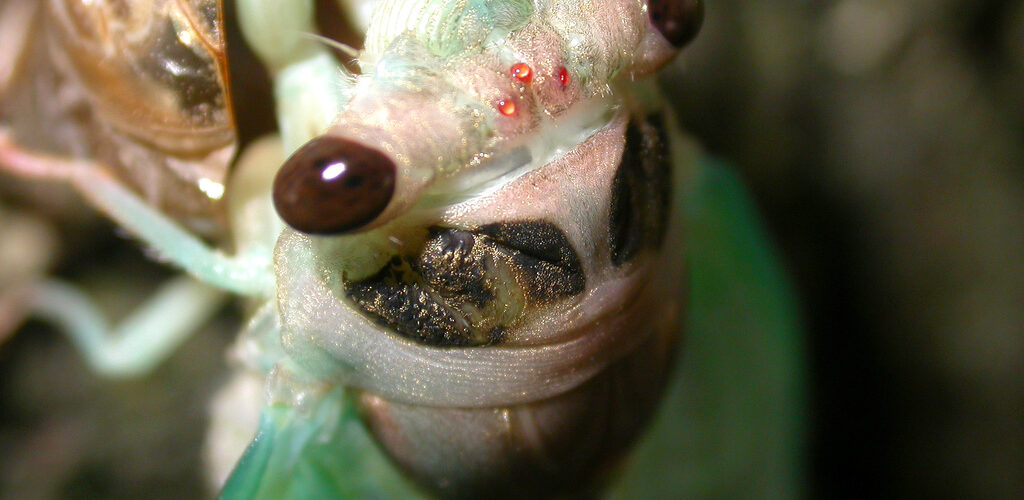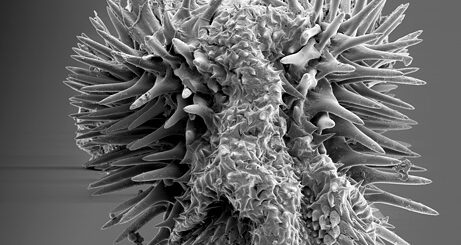The Curious Incidence of the Cicadas in the Springtime

The term ‘periodical cicada’ encompasses the set of species belonging to the genus Magicicada. They are red-eyed, black and orange bodied insects exclusive to North America, known for their characteristic chorus singing, for occasionally turning up as ingredients in novel low-carb recipe ideas and, most notably, for the length of their life-cycles: 13 or 17 years depending on the species. Being, small, plentiful and tasty doesn’t sound like a reliable long-term survival strategy. However, cicadas have managed to populate the earth for four million years, and their success appears to lie in their prime-numbered life-cycles.
The Magicicada genus comprises seven separate species; four with 13 year life-cycles and three with 17 year life-cycles. Cicada nymphs spend their formative years underground, sipping juices from roots and slowly maturing. In the springtime of their final (13th or 17th) year, they emerge and quickly become fully mature adults, then court, mate, lay eggs and, after a few weeks, die. While above ground, cicadas overwhelm the surrounding environment, inconveniencing Americans with outdoor plans to an extent that has earned them the title ‘17- (or 13-) year locusts’. Local populations are synchronised such that they all emerge in the same year (even if they consist of different species), leading to huge population densities. Other cicada species — collectively known as annual cicadas, although their life-cycles can be up to ten years — do not exhibit this harmony and instead appear every spring, generally in smaller numbers. Scientists have offered several explanations for the distinctive life-cycle pattern of periodical cicadas, usually focused on predator avoidance. By far the greatest threat to cicadas is their impressive range of predators which includes bats, spiders and squirrels.
Cicadas have adopted a strength in numbers approach — a technique known as predator satiation. Cicadas are easy prey but it is hard for predators to put a dent in their population, ensuring that enough of them survive to maintain the species. Various other life forms have evolved to use predator satiation as a means of protection when they are at their most vulnerable stage of life. Metamorphosis of larvae in some species of frogs and salamanders is often well coordinated, such that the majority make the passage from water to land at the same time. In the botanical world, plants generate seeds in abundance over a short period of time so that even once herbivores have had their fill, there are enough leftover to begin the next generation 1. This is in contrast to large mammals, for example, which tend to produce a small number of offspring that require a lot of effort to raise but have a good chance of survival. Cicadas rely not on the survival of the fittest individual members, but rather on the synchronicity of the whole population. The most important requirement for individual cicadas is an adherence to the 13- or 17- year emergence schedule. Deviation from that schedule means likely death.
Since predator satiation is a trait common to all cicada species, the advantage of the periodical cicadas’ life-cycle in particular seems to be related to its length. Cicada predators typically have 2-5 year life-cycles2. If the cicadas emerged this frequently, predators could adjust their life-cycle so that the arrival of a new generation would coincide with a plentiful cicada population for their young to feast on. By eclipsing the normal predator life-cycle, the cicadas leave no scope for a predator to adapt to a life-cycle that would cause a systematic concurrence of new generations and adult cicada emergence; any coincidence is down to chance.
Most remarkably, 13 and 17 are prime numbers. Cicadas with non-prime life-cycles are especially vulnerable to predators whose life-cycles are a divisor of their own. If periodical cicadas remained underground for, say, 15 years, every time the adults surfaced they would be faced with hungry 3- or 5-year predators in-phase with them. However, a 17-year cicada will only have this problem with a particular 3-year predator every 17×3 = 51 years, and a 5-year predator every 17×5 = 85 years — that’s a long time to recover. Although periodical cicadas still have to cope with opportunistic predators, computer simulations 3 confirm that this indeed a good survival strategy.
A more recent and widely accepted hypothesis 4 regarding the dominance of prime-numbered life-cycles is that they developed independently multiple times over the last 4 million years during glacial periods, when low temperatures around the cicadas’ habitat left them less able as a species to reproduce. It is thought that hybridisation between populations with different life-cycles led to poorer periodical accuracy in the resulting offspring. Cicadas with prime life-cycles were less likely to coincide and hybridise; they did not experience the same degradation, and so benefited from greater population densities when they did emerge.
Details of the biological mechanisms that drive cicada periodicity remain unclear, and their long lifespan makes it difficult to investigate this by studying consecutive generations. A popular approach is to test reasoning with computer simulations. Alternatively, interested parties can check the cicada calendar here and observe them in real time.
This article was specialist edited by Robyn Womack and copy edited by Madeline Pritchard.
References
- http://science.jrank.org/pages/5480/Prey.html
- Ever Since Darwin: Reflections in Natural History by Stephen Jay Gould. Publisher: W.W. Norton, 19920
- http://www.cicadamania.com/downloads/prime-PRL.pdf
- https://www.ncbi.nlm.nih.gov/pmc/articles/PMC2690011/











1 Response
[…] more recent and widely accepted hypothesis 4 regarding the dominance of prime-numbered life-cycles is that they developed independently multiple […]